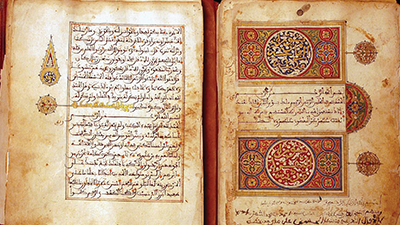State Building in Africa
Teacher Resources
Driving Question: How was the process of state formation similar and different in various regions of Africa from c. 1200 to 1450 CE?
As in Eurasia and the Americas, state systems in Africa instilled order through a variety of administrative institutions, policies, and procedures. They also varied by region, implementation, and purpose.
Learning Objectives:
- Explain how and why states in Africa developed and changed over time.
- Explain a historical concept, development, or process.
Vocab Terms:
- bureaucracy
- caliphate
- matrilineal
- state
Opener: State Building in Africa
To teach this lesson step, refer to page 2 of Lesson 1.5 Teaching Guide.
What does comparing and contrasting look like in the social studies classroom? Check out this video to find out!
You have the opportunity for a free trip in a time machine traveling to 1200 CE. Are you hopping in or not?
Africa 1200–1450
To teach this lesson step, refer to page 6 of Lesson 1.5 Teaching Guide.
For an in-depth look at Swahili city-states of East Africa, check out this blog post.
Communities are often organized along some hierarchical line—but how does one reach the top? In Africa c. 1200–1450, the path to the top was paved with tribal loyalty, trade, and religion.
-
Guiding Questions
-
Before you read
Preview the questions below, and then skim the article. Be sure to look at the section headings and any images
While you read
Look for answers to these questions:
- What are some different ways of organizing communities that Africans used in the period 1200–1450?
- What group of people were particularly influential in the governing of Swahili city-states?
- What kinds of factors helped individuals to elevate themselves to be chiefs and then kings in the southern African region that included Great Zimbabwe?
- Tyo was a confederation. Kongo was an empire. What was the difference between the two? What were the similarities?
After you read
Respond to the following questions:
- To what extent does this article explain how and why states in Africa developed and changed over time?
- What factors stand out to you as particularly distinct and important in the way communities were organized in Africa in this period? How do these seem similar or different to other parts of the world you have studied in this period?
Comparison: States 1200–1450
To teach this lesson step, refer to page 7 of Lesson 1.5 Teaching Guide.
For more on comparison, check out the Comparison Topic Page.
Ready to add a few stamps to your time-travel passport? It’s time to dig into a comparison of how different regions governed their people, managed resources, and created communities between 1200 and 1450.
State and Empires of West Africa
To teach this lesson step, refer to page 12 of Lesson 1.5 Teaching Guide.
Not all states and empires are the same. Factors such as geography, culture, and even climate may dictate how governments are instituted and run. In West Africa during the period c. 1200–1450, if you could manage farmers, you could manage an empire.
-
Guiding Questions
-
Before you read
Preview the questions below, and then skim the article. Be sure to look at the section headings and any images.
While you read
Look for answers to these questions:
- Who was Mansa Musa, and why might he have had a problem with his portrayal in the first photo?
- Examine the map shown in the article. What does it tell us about settlements of communities in the Sahel?
- What is the Sahelian state model? What is its significance?
- What is religious pluralism? How does it relate to studying West African communities?
- What are some of the arguments for and against considering Mali an empire?
After you read
Respond to the following questions:
- Describe the extent to which this article explains how and why states in Africa developed and changed over time.
- Based on the evidence in this article, what was unique about the states of West Africa in this period, and what features did they share with states in other regions?
- How does this article support, extend, or challenge your understanding of the “state” when viewed through the filter of the governance theme?
Closer: State Building in Africa
To teach this lesson step, refer to page 14 of Lesson 1.5 Teaching Guide.
Need some tips for getting your students to ACE an SAQ? Follow this thread where teachers are sharing their best strategies!
The Short Answer Question (SAQ for short) on the Advanced Placement exam can be stressful; however, you will be an ACE at answering them once you learn how to Answer, Cite, and Explain!






